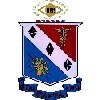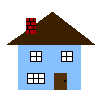6.829 Computer Networks (H)
How The Internet Really Works
(3.3
1.5
7.1)
Lecturer: H. Balakrishnan
Lecturer's Rating: H. Balakrishnan 6.3/7.0
Prerequisites: 6.033, C, Perl, Tcl, time
|
Response rate: 54 out of 105
Difficulty: 5.2/7.0
Overall Rating: 5.9/7.0
Term Evaluated: Fall 2002
|
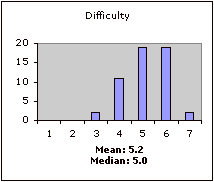
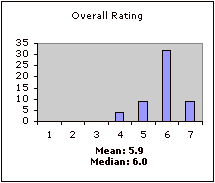
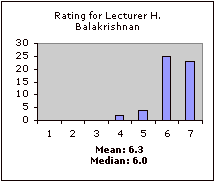
Lecturer's Comments:
None.
The class provides an overview of the current topics in computer networking:
protocols, scalability, routing, robustness, and security. There is also
emphasis for students to learn how to do a research project. Most students were
graduate students, seniors, and MEng students in VI-2 and VI-3. A few
undergraduates felt overwhelmed.
|
WHAT'S HOT
- Lectures
- Topics cover current issues
- Cool papers, cool projects
- Lecture notes
|
WHAT'S NOT
- Long problem sets
- Slow homework return
- Lots of reading
- Too little lecture notes
- Too much on routers
|
Students took this class for their interest in the subject. They found a good
level of detail, with the content as expected. While many people agreed with the
balance of theory and application, some felt that the theory was
overemphasized.
Lecturer H. Balakrishnan (6.3/7.0, 54 responses) was universally praised
for his good lecturing style, and for his knowledge of the subject matter.
Students also found him enthusiastic and very clear -- "He's
the most bubbly, energetic, and well-spoken I've ever seen." Students also
applauded his board technique, and his ability to keep their interest. The few
criticisms are that he sometimes goes a bit fast over difficult or technical
details, and that he needs to speak more slowly. Additionally, his
abbreviations caused a little confusion.
TA N. Feamster (5.2/7.0, 41 responses) was praised for being very helpful.
Students found him willing to answer questions and on top of the material.
TA T. Nightingale (5.2/7.0, 34 responses) was also helpful, and good at
tutorials.
TA J. Strauss (4.7/7.0, 33 responses) received positive
comments, but negative comments as well. Several students thought he was
impatient and not helpful, sometimes answering questions tersely.
The problem sets were very long, taking on average 17 hours each. However,
they were helpful for learning the material. Students felt they were
difficult, and involved some grunge work. Several students remarked that the
problem sets assume some prior knowledge in networking and explore concepts not
discussed in class. Students also complained that solutions needed to be
distributed sooner. One common suggestion was that problems sets should be shorter
and more frequent. Almost all students collaborated to some extent and found
it helpful. Bibles were rarely used.
There was a design project that many students felt was a good experience. It
was very long and open ended. A few students found it difficult and time consuming.
Feedback was sometimes sparse, and narrowing the scope for the project was
difficult. Additional structure would have helped, such as more check points.
The lecture notes were widely praised. They were comprehensive and well written,
and the lectures that had corresponding notes were much easier to understand.
However, most students complained that not every lecture had notes.
Grades in 6.829 are based on 3 problem sets (25%), 2 quizzes (30%),
participation (5%), and a project (40%).
The exams were difficult and a little long for an hour. Students felt that they
were graded fairly, but didn't adequately test one's grasp of the material. A
few students complained about multiple choice sections.
The most common advice is that students should have sufficient time to spend on
this class. Because of the open-ended nature of the class, students who spend more
time get more out. Several students suggested to study for the exams by doing
the readings and thinking about them.
"A pleasure to learn from an expert in the field"
"A lot of reading to keep up with"
Dated: January 17, 2003
Eta Kappa Nu, MIT
